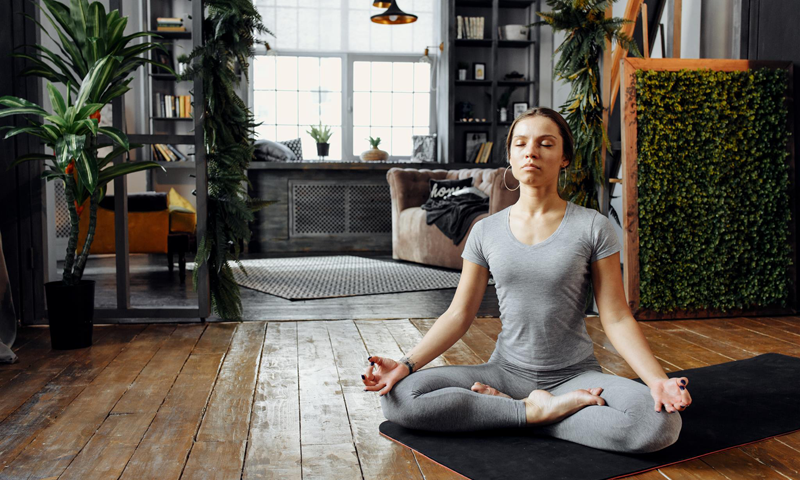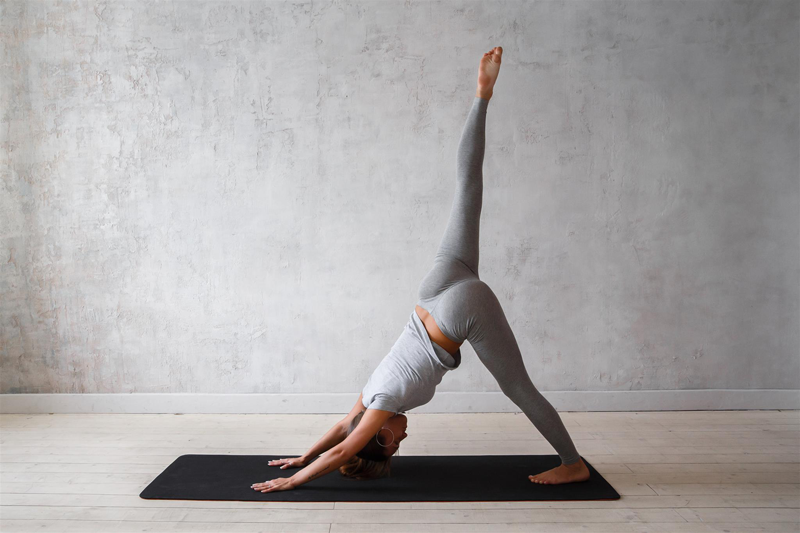
What is Yoga Satyananda?
1st June 2018
How to Tone Your Arms with Yoga
13th June 2018How to Make Yoga Your Lifestyle

While a weekly yoga class teaches the physical aspects of yoga, many yogis enjoy living a yoga lifestyle off the mat, too. Far more than asanas and breathing techniques, those living a yoga lifestyle adopt healthy practices and attitudes to achieve enlightenment. In this article, we explore exactly how to make yoga your lifestyle. While a yoga lifestyle is more than just physical movement, regular asana practice is one of the key steps. Before practising asanas, it’s important to pick up the right gear. A breathable yoga top will allow the body to oxygenate sufficiently and prevent you from overheating.
What is a Yoga Lifestyle?
To live a yoga lifestyle, you need to do far more than practice postures and breathing techniques. A yoga lifestyle is about adopting healthy practices and attitudes, with the ultimate goal of achieving enlightenment.
The Hindu scripture, the Bhagavad Gita, explains that yoga is in all that you do. According to the text: “It’s not that you are just going into a corner, sitting with the spine erect and then doing some japa or some breathing and that is Yoga. My Yoga is everything. All that you do is Yoga.”
The Eight Limbs of Yoga
Ancient yogic texts speak of the Eight Limbs of Yoga, which describe the eight different aspects of a yoga lifestyle. These are Yama, Niyama, Asana, Pranayama, Pratyahara, Dharana, Dhyana, and Samadhi. Practising each of the Eight Limbs helps you to balance the body, mind, and spirit.
The first two limbs are Yama and Niyama. The word ‘Yama’ translates to ‘control’, while ‘Niyama’ translates to ‘non-control’. To explain this simply, they are the do’s and don’ts of the practice. Yama teaches you to abstain from violence, stealing, dishonesty, greed, and sexual misbehaviour. Niyama promotes contentment, cleanliness, self-examination, and dedication to the Supreme Lord. The third limb, Asana, means ‘posture’. Yogis can complete this aspect by practising physical yoga poses regularly. The fourth limb is Pranayama. When translated from Sanskrit, Prana means breath or life energy. This limb teaches practitioners how to control physical and spiritual energy through breathing techniques. The fifth limb, Pratyahara, focusses on concentration. Practitioners must learn how to use the energy created from Pranayama. The sixth limb is Dharana. This limb is all about the balance of inner awareness. Many yogis believe that their inner awareness is unstable until Dharana has been achieved. Dhyana, the seventh limb, focusses on absorption. Practitioners must meditate regularly and learn how to absorb the benefits. When Dhyana has been achieved, yogis will be able to reap the benefits of meditation without having to concentrate. The final limb is Samadhi. When translated from Sanskrit, this means ‘oneness’. To achieve Samadhi, practitioners must learn how to disperse their ego into their inner awareness. Once this has been done, there is nothing to stop them from achieving enlightenment.
How to Practice
Be Honest to Others
To live a yoga lifestyle, you must be honest with yourself and others. When you speak, make sure it’s from the heart. Speak the truth openly without lying. Even though white lies are used to spare feelings, they can still taint your integrity. When telling stories, it’s important not to exaggerate – even for dramatic effect!
Be Honest to Yourself
As well as being honest with others, you must be honest with yourself. Looking at yourself from a third person perspective will allow you to see the good and bad in yourself. This way, you can congratulate yourself on your good points, and work to improve anything bad.
Be True to Yourself
When living a yoga lifestyle, it’s important to be true to who you are. Take time to get to know yourself. When you know what you believe in, always stand up for your beliefs and speak from the heart.

Treat Your Body With Kindness
Always treat your body with kindness. Feed your body with clean, healthy foods and avoid anything non-nutritious. Take time to listen to your body and provide it with what it needs – whether that is sleep, food, rest, or exercise.
Don’t Hurt People
While it’s important not to hurt the people you love, it’s also important not to hurt those you hate. Living a yoga lifestyle means being kind to everybody – regardless of how they are treating you. Not only does this mean hurting others physically, but it also means emotionally. Think before you speak to avoid hurting those around you with harmful words.
Don’t Steal
Don’t take something that doesn’t belong to you. Whether it’s property, credit for a job, a compliment, or opportunity, don’t take it if it belongs to someone else.
Help Those in Need
Whenever you can, offer help to those in need. When doing this, it’s important not to expect anything in return. However, many yogis consider this as good karma. If you’re in a position to help another, you should do so without negative thoughts.
Be Happy With What You Have
When living a yoga lifestyle, you should be happy with what you have. Instead of longing after things you don’t have, count your blessings. Don’t compare yourself to others, as this will result in jealousy and unhappiness. Be content with who are you and what you have in life.
Live With an Open Mind
Finally, live with an open mind. Don’t judge too quickly, and always be open to trying new things. If others have beliefs you disagree with, try to accept these without passing judgement.
In Summary
Whether you’re an experienced yogi or a complete beginner, follow the tips above if you’re wondering how to make yoga your lifestyle. If you find yourself struggling, consider picking up a love tuner mindfulness tool. Designed to align the body and mind, the single tone flute can help you to relax and engage with the practice.

